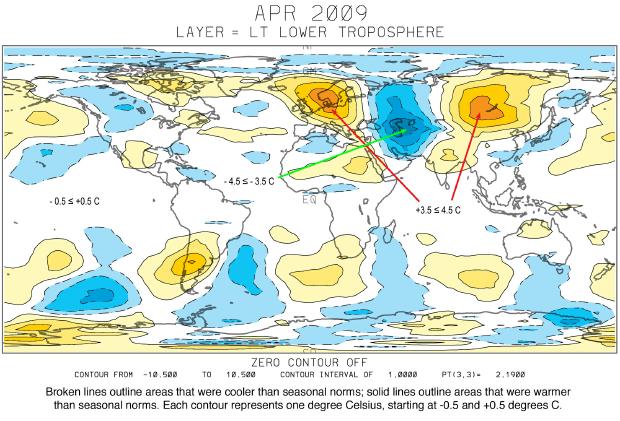Global warming isn't spiking but the global composite temperature during April revealed an increase above the 20-year average for that month. The report is issued monthly as part of an ongoing joint project between The University of Alabama in Huntsville, NOAA and NASA.
As part of an ongoing joint project between The University of Alabama in
Huntsville, NOAA and NASA, Dr. John Christy, director of U.A. Huntsville's
Earth System Science Center, and Dr. Roy Spencer, a principal research
scientist in the ESSC, use data gathered by microwave sounding units on NOAA
and NASA satellites to get accurate temperature readings for almost all
regions of the Earth. This includes remote desert, ocean and rain forest
areas for which reliable climate data are not otherwise available.
The satellite-based instruments measure the temperature of the atmosphere
from the surface up to an altitude of about eight kilometers above sea
level. Once the monthly temperature data is collected and processed, it is
placed in a "public" computer file for immediate access by atmospheric
scientists in the U.S. and abroad.

CLICK IMAGE ABOVE TO SEE FULL SIZE. Broken lines outline areas that were cooler than seasonal norms while solid lines outline areas that were warmer than seasonal norms. Each contour represents one degree Celsius, starting at -0.5 and 0.5 degrees C.
Global climate trend since Nov. 16, 1978: +0.13 C per decade
April temperatures (preliminary)
Global composite temp.: +0.09 C (about 0.16 degrees Fahrenheit) above
20-year average for April.
Northern Hemisphere: +0.13 C (about .23 degrees Fahrenheit) above 20-year
average for April.
Southern Hemisphere: +0.05 C (about 0.09 degrees Fahrenheit) above 20-year
average for April.
March temperatures (revised):
Global Composite: +0.21 C above 20-year average
Northern Hemisphere: +0.31 C above 20-year average
Southern Hemisphere: +0.10 C above 20-year average
(All temperature variations are based on a 20-year average (1979-1998) for
the month reported.)
Neither Spencer nor Christy receives any research support or funding from
industrial or environmental activist companies or organizations, or from any private or
special interest groups. All of their climate research funding comes from
state and federal grants or contracts.


